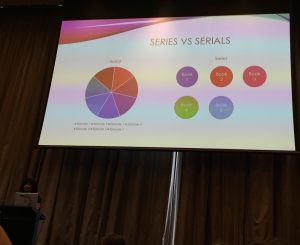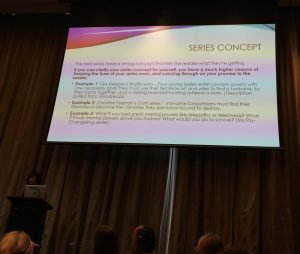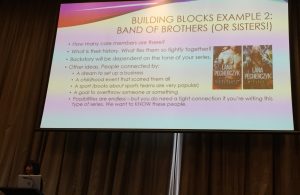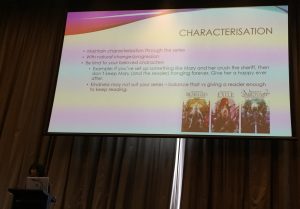Nalini Singh on Writing Series
This represents my notes on the presentations at the 2019 Romance Writers of Australia conference held in Melbourne. Please consider my status as an imperfect recorder. I hope you enjoy reading about this conference as much as I enjoyed being there. This blog uses affiliated links.
Serial vs series

Nalini defines ‘serial’ books as those that are episodes, while ‘series’ are stand alone books connected to each other.
Types of series
Type One: Connected Characters
- eg family, rock stars, spaceships, animals, can be non-human.
- No overarching series arc, each book stands alone, readers can dip in and out but they may get less connection to the world.
- Readers might only read one or two in the series.
Connected Characters can also be connected over multiple series
- Multiple points for entry
- Con: if the reader doesn’t like the world, you’ve lost them for all your books
- Eg: Valdemar series by Mercedes Lackey
As a writer, think about multiple entry points for your readers

Type Two: Overarching Plotline
Each book is a separate romance, but an overall plot connects the series. Connectivity is the key.
- Readers pay attention to coherence and continuity in this type of series
- Con: less entry points
- Pro: readers are passionate fans
- More prevalent in spec-fic due to the world building, or in romantic suspense where the crime is solved over the series
Knowing the type of series helps you market the books.
Type Three: the rest
Some series have multiple books for the same characters and show the relationship evolving and growing over time.
Series Concept

The best series have a strong concept, eg Kleypas Wallflowers. Category romance taglines are great, eg “Feuding family saga”
Building books
You want the reader to follow you. Usually book 1 sells well, then there is a drop off for book 2. The trick is to hold the reader from book 2 through the rest.
One: Family
- Sketch out a family tree, eg Stephanie Laurens
- Do the ground work to build one before you start, and an extended family gives you series opportunity
- Generational series can be hard to pull off because if people die, readers HATE it.
- Work out characters ages compared to each other
Two: Band of brothers/sisters

- How many core members? Stick with the original group and don’t just add, eg 4 brothers, 7 business owners
- What ties them together?
- What is their history? Eg Nora Roberts Bride quartet
- Their backstory will depend on the tone of the books
Three: Place
- Sketch out a map of your location
- Favourite place with people
- Can allow for broader series options than band of sisters as characters are not so closely connected
- Feeling of ‘home’
- Side characters will flow through books
Timeline
- Think about ages compared to other characters
- Be careful younger characters are older than 18
- Keep a timeline to avoid time squishing
- Specific references to events have more impact than vague ‘a few weeks’
- Don’t use this as a procrastination tool
- Have a series timeline to keep track of pregnancy, child’s ages, etc
- A timeline will save you working time in offshoot series and helps ensure a characters isn’t in two places at once in different books (oops)
Character Introduction

Short series (up to 5 books) you can meet all characters in book 1
Long series (5+ books) introduce characters over several books in stages. It’s impossible for everyone to appear in every book.
Foreshadow relationships in earlier books with hints, not sequel bait
Sequel baiting
- Make it a natural insert, not a gatecrasher at a party
- Bring in surprise new blood
- Draw secondary characters quickly so they don’t take over
- Maintain characterisation through the series. Avoid personality transplants but include natural growth too, they can’t be static
Characters needs to be memorable and interesting (not necessarily likeable), and even alpha heroes need to be different.
Write tight – it improves pacing
Make characters feel like family to the reader
- They have likes and dislikes
- They don’t have to be likable, just relatable. Some friction is good for tension, but remember your overall tone
- Be kind to your characters
Long series
You must know where you are going
- Maintain coherence
- Don’t scramble for the conclusion
- Readers need to see the pieces come together
- Make it satisfying
Answer the question you asked at the start. Give readers what you promised.
World Building

Choose of a series that has emotional power for you. If it’s successful, you might have to write that world for a decade or more. You’ll want to enjoy it.
Nalini Singh’s latest release is:
